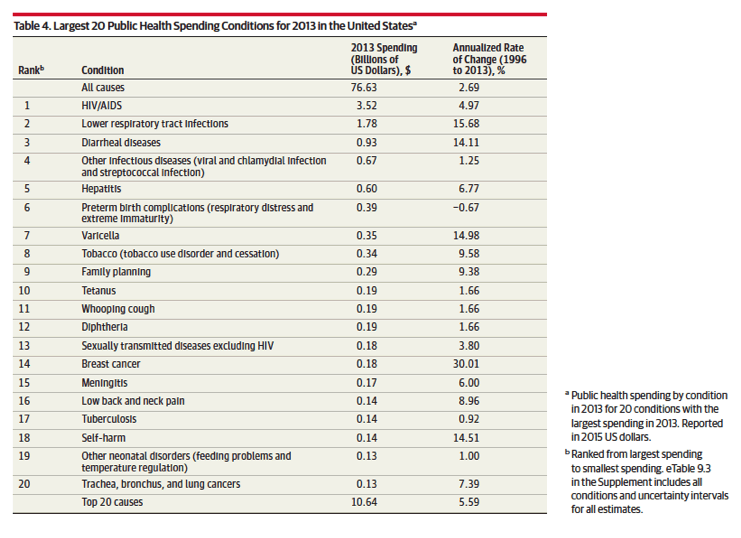| |
Health & AIDS Spending USA
|
| |
| |
Download the PDF here
Download the PDF here
"The single largest proportion of public health spending is for HIV/AIDS, at $3.52 billion, even though HIV/AIDS ranks 75th on the list of health spending ($4.8 billion) and was the cause of death for only 6721 US residents in 2014 (although 13 700 people with HIV/AIDS died)-about 0.25% of all deaths in the United States in 2014. In 2013, HIV/AIDS was far down the list of common causes of death-well below suicides, motor vehicle crashes, and smoking. Even among 25- to 34-year-olds, HIV/AIDS was only the eighth leading cause of death, ranking behind even diabetes for this age group.18 "

Federal Government Public Health Spending
In 2013, 23.8% (UI, 20.6%-27.3%) of government public health spending was provided by the Health Resources and Services Administration, the Centers for Disease Control and Prevention, the Substance Abuse and Mental Health Services Administration, and the US Food and Drug Administration. Some of these resources were spent via federally run programs, whereas some of the spending was used to finance public health programs run by state and local governments. Table 4 reports estimated spending on the 20 conditions with the most public health spending. HIV/AIDS was estimated to be the condition in 2013 with the most federal public health spending, with an estimated $3.5 billion (UI, $3.3 billion-$4.3 billion) spent in 2013. The second-largest and third-largest conditions of federal public health spending in 2013 were estimated to be lower respiratory tract infections and diarrheal diseases, with an estimated $1.8 billion (UI, $1.2 billion-$2.1 billion) and $0.9 billion (UI, $0.7 billion-$1.0 billion) spent, respectively.
Spending on Those 65 Years and Older
Because of the aging US population and political concerns about the financing of Medicare, there is increasing interest in health care spending on the oldest age groups. An estimated 37.9% (UI, 37.6%-38.2%) of personal health care spending was for those 65 years and older in 2013. Spending per person was greatest in the oldest age group, reaching an estimated $24 160 (UI, $23 149-$25 270) per man and $24 047 (UI, $23 551-$24 650) per woman. For those 65 years and older, 36.8% (UI, 36.2%-37.2%) of spending was in inpatient hospitals and 21.7% (UI, 21.4%-21.9%) was in nursing facility care, and the largest conditions of health care spending were estimated to be IHD, hypertension, and diabetes.
---------------------
Editorial
December 27, 2016
How Can the United States Spend Its Health Care Dollars Better?
Public Health and Prevention
Spending priorities for public health remain rooted in a time when infections were the primary health threat. Today, the top 5 conditions for public health spending are all communicable diseases (Table 4 in the article by Dieleman et al). The single largest proportion of public health spending is for HIV/AIDS, at $3.52 billion, even though HIV/AIDS ranks 75th on the list of health spending ($4.8 billion) and was the cause of death for only 6721 US residents in 2014 (although 13 700 people with HIV/AIDS died)-about 0.25% of all deaths in the United States in 2014. In 2013, HIV/AIDS was far down the list of common causes of death-well below suicides, motor vehicle crashes, and smoking. Even among 25- to 34-year-olds, HIV/AIDS was only the eighth leading cause of death, ranking behind even diabetes for this age group.18 Conversely, few public health dollars focus on lifestyle conditions that ultimately contribute to the majority of chronic illnesses seen today. Tobacco control, for example, receives the eighth most public health dollars at $340 million, accounting for only 1/10 000th of total health care spending. Similarly, low back pain receives a mere $140 million in public health spending, and suicide (described as "self-harm" by Dieleman et al) receives only $140 million.
The disconnect between public health spending and health care costs needs to be systematically reevaluated. More public health dollars should be directed toward changing lifestyle conditions by emphasizing tobacco control, nutrition, exercise, suicide prevention, and substance abuse.
|
|
| |
| |
|
|
|